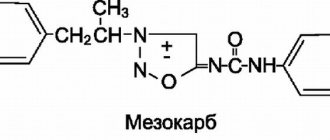Has restrictions during pregnancy
Prohibited during breastfeeding
Prohibited for children
Has restrictions for older people
Has limitations for liver problems
Has limitations for kidney problems
Muscle relaxants are widely used to relieve spasms, increase the mobility of affected muscles and relieve pain symptoms. Mydocalm is an effective and frequently prescribed remedy in this group, which has a rapid effect and helps reduce muscle tone. However, in some cases it is necessary to use inexpensive analogues of Mydocalm, which no less quickly have the desired effect and are not inferior in their characteristics to expensive equivalents.
The main active ingredient in Mydocalm is tolperisone, which acts as a centrally acting muscle relaxant, helps to relieve the manifestations of diseases of the musculoskeletal system, improves the functioning of the nervous system and copes with inflammatory diseases. The advantage of the drug is that it is available in two forms: tablets and ampoules.
Mechanism of action of Mydocalm
Its bioavailability is 15-20%. The drug actively interacts with nervous tissue, reaching high concentrations in the spinal cord and brain, as well as in the peripheral nervous system. Mydocalm reduces the excitability of motor neurons and inhibits the activity of sodium channels, increasing blood circulation.
The medication is most often prescribed for the following pathologies:
- muscle spasms;
- arthrosis of large joints;
- postoperative period in traumatology.
Contraindications to the use of this drug are:
- drowsiness;
- headache and pain in limbs;
- noise in ears;
- heat;
- irritability.
Dosage form
Mydocalm is a Hungarian medicine intended to relieve muscle spasms and restore metabolism.
Sold in tablet form, as well as in the form of a solution for injections, sealed in ampoules.
The tablets contain 50 or 150 mg of the active substance - tolperisone. One package includes 30 tablets.
One ampoule contains 1 ml of a medicinal solution, including 100 mg of the active ingredient, and another 2.5 mg of lidocaine, an anesthetic. One package contains 5 ampoules.
Indications for use
The drug is prescribed for the following pathologies:
- changes in bone or muscle tissue, accompanied by spasms;
- cerebral palsy, which is spastic diplegia;
- encephalopathy complicated by muscular dystonia;
- stroke;
- multiple sclerosis;
- obliterating atherosclerosis;
- Raynaud's syndrome;
- myelopathy;
- encephalomyelitis;
- intermittent angioedema;
- negative consequences of muscle surgery.
Contraindications for use
The medication has a small list of contraindications and is usually well accepted by the body. A muscle relaxant should not be used only if there is intolerance to active substances, including lidocaine. Also, injections of the drug are prohibited for children under 3 years of age.
Pregnant women are not contraindicated in treatment with Mydocalm, but it is extremely undesirable, especially in the first weeks of pregnancy.
Whether or not the expectant mother takes the medication is decided only by a medical specialist in each specific case.
The same applies to patients who are breastfeeding.
Instructions for use of Mydocalm
The optimal daily dose for an adult patient is 150 mg of the drug.
It is enough to take 1 tablet of 50 mg 3 times a day to get rid of spasms.
But if the spasmodic attacks are intense, the doctor may prescribe the patient a higher dose of medication.
Children are prescribed 1 tablet of 50 mg per day. The tablet can be divided into several doses. If it is difficult for a small child to swallow the medicine, the tablet can be ground into powder. The therapeutic course can last no more than 10 days.
Injections of the drug can be both intramuscular and intravenous.
Injections into the muscle are made twice a day, 100 mg of the drug. Injections into a vein are made once a day, 100 mg of the active substance.
It is impossible to plan a therapeutic course and dosage without consultation with a medical specialist. Only a doctor can prescribe the optimal course of treatment and effective daily dose.
Mydocalm is good because it can be taken without fear with any other medications. Also, the activity of the drug is not inhibited by alcohol, therefore, during treatment with a muscle relaxant, drinking alcoholic beverages is allowed.
Cheaper tablets
The following effective and cheaper analogues of the medicine in tablets have a quick effect and successfully cope with the removal of symptoms associated with dysfunction of the musculoskeletal system. All of them are centrally acting muscle relaxants. Before choosing an analogue of a medication, you should consult a doctor to assess the potential health risks from using the drug.
Baklosan
This effective analogue of Mydocalm relieves muscle tension, clonic spasms and painful spasms. The active ingredient of the tablets is baclofen. The product helps to facilitate physical therapy aimed at developing joint mobility and preventing osteochondrosis. Baklosan is prescribed for the following diseases:
- multiple sclerosis;
- spinal cord diseases;
- tumors;
- meningitis.
The average daily dose of the drug is 10 mg, which can be gradually increased to 20 mg. The dose and duration of treatment with Baklosan should be determined by a doctor, since for older people and patients with high sensitivity, the dose increase should be slower. The final dose should not impair motor functions. The following undesirable effects from taking the drug are possible:
- drowsiness;
- sleep disorders;
- ataxia;
- nausea;
- respiratory depression.
Baclofen
This medication is taken orally three times a day with meals. The initial dose is 5 mg, then gradually increases daily to 30-70 mg per day. The daily dose of the drug should not impair physical functions and exceed 100 mg.
Pediatric practice includes the use of this drug, but the dose cannot be higher than 30 mg per day for children under 6 years of age and 60 mg for patients over 10 years of age. For both adults and children, the dose of the drug should be reduced gradually over the course of a week.
Action of Baclofen
Indications for prescribing the drug are:
- High muscle tone in multiple sclerosis.
- Spinal cord diseases.
- Meningitis.
- Intracranial injuries.
Baclofen has high absorption, the maximum effect of administration occurs after two hours. The drug rarely causes temporary side effects, but if they occur, they are manifested by the following symptoms:
- Visual impairment.
- Respiratory depression.
- Urinary retention.
- Hypothermia.
- Abdominal pain.
Miolgin
Miolgin is a combination drug, its active components are chlorzoxazone and paracetamol. After taking the medicine, there is a rapid decrease in pain and an increase in muscle contractile function.
Due to its composition, Miolgin has a general relaxing effect and maintains the tone of striated muscles, but does not have a tranquilizing effect.
The drug is indicated for spasmodic muscle conditions that may occur due to injury or sprain. In addition, the medication effectively copes with headaches and paroxysmal lower back pain. Used orally, three times a day, 1-2 caps. The maximum permissible daily dose should not exceed 6 tablets.
Indications for use of the medicine are as follows:
- Spasms of striated muscles.
- Arthritis.
- Painful conditions of the spinal cord.
- Cerebral paralysis.
- Muscle injuries and strains.
Arthritis
Absolute contraindications include pregnancy and lactation, childhood and sensitization to individual components of the drug.
Sirdalud
The muscle relaxant containing tizanidine acts on spinal cord receptors, inhibits spinal neurons and reduces increased muscle tone. Its use also reduces the strength of cramps and spasms. In addition, the drug acts as an anesthetic. The medication is indicated for the following diseases:
- pathologies of the cervical and lumbar regions;
- cerebrovascular accidents;
- myelopathy.
Description of the drug
Absolute contraindications for use are:
- intolerance to individual components of the drug;
- liver dysfunction;
- pregnancy and lactation period.
The medicine is intended for oral use. You need to take the medication at regular intervals three times a day. The dose should be limited to 4 mg at a time per day. The dose is gradually increased as treatment progresses to 25 mg per day. It is not necessary to take the medication with food; eating at the same time as this medication does not affect its absorption.
Tizalud
The medicine, produced in tablet form, is used to relieve conditions in which it is difficult for a person to bend their limbs due to high muscle tone. This condition can occur due to various neurological diseases. In addition, the medication is widely used for the treatment of skeletal muscle spasms, which can be caused by spinal surgery.
Tizalud therapy should be started with a minimum dose, which is usually 2 mg. The drug must be taken three times a day, gradually increasing the daily dose to 36 mg.
The course of treatment with Tizalud should be completed gradually. Abruptly stopping the medication can cause tachycardia, a sharp increase in blood pressure and stroke. The medicine is contraindicated in case of serious liver dysfunction and during pregnancy.
An overdose of Tizalud is rare. However, if the maximum acceptable dose is exceeded, the patient experiences drowsiness, dizziness, nausea and vomiting. To stabilize the condition, you need to rinse your stomach and take activated charcoal.
Tizanidine
Tizanidine regulates the tone of skeletal muscle tissue and relieves cramps and spasms. This muscle relaxant is also widely used in the following cases:
- osteochondrosis;
- hemiplegia;
- spinal cord diseases;
- traumatic brain injuries.
Pharmacodynamics of Tizanidine and analogues
The initial dose of Tizandine is the same as that of all analogues described above, but it must be prescribed and monitored by a physician. Uncontrolled use of the drug leads to a decrease in blood pressure, drowsiness and dizziness, difficulty breathing and coma. Tizanidine is contraindicated during pregnancy, childhood, and liver and kidney diseases. At the beginning of treatment with this medication, it is advisable to limit activities associated with the need for high concentration of attention.
Mydocalm analogues are cheaper (list with prices)
Mydocalm is a popular drug. It is one of the most commonly purchased muscle relaxants. However, pharmacies sell a large number of analogues that cost less than Mydocalm. Substitutes in composition and principle of action, produced by different manufacturers, cost 200 - 500 rubles, and have several forms of release.
Below are listed analogues cheaper than Mydocalm, available in injections and tablets:
- Tolperisone – 280 rubles;
- Sirdalud – 340 rubles;
- Baklosan – 370 rubles;
- Baclofen – 380 rubles;
- Miolgin – 230 rubles;
- Texamen – 240 rubles;
- Vitaxon – 190 rubles;
- Trigamma – 145 rubles;
- Meloxicam – 155 rubles;
- Calmirex – 450 rubles.
Prices for the drug and its main analogues, average in Russia
The price of Mydocalm, its domestic and foreign analogues may vary depending on the pharmacy and region.
| Drug name | Release form | Average price (in rubles) |
| Mydocalm | Tablets and ampoules | 382-301 |
| Miolgin | Pills | 310-343 |
| Sirdalud | Pills | 285-294 |
| Dexamethasole | Ampoules | 203-223 |
| Neurobion | Ampoules | 277-280 |
| Baklosan | Pills | 280-285 |
| Baclofen | Pills | 266-490 |
| Tizalud | Pills | 159-220 |
| Tizanidine | Pills | 132-190 |
| Ambien | Pills | 1700-2200 |
| Amelotex | Ampoules | 119-224 |
| Arthrozan | Ampoules | From 149 |
| Mesipol | Ampoules | From 212 |
Sirdalud or Mydocalm - which is better?
If the question arises of what to replace Mydocalm with, then the most popular analogue is the Swiss drug Sirdalud.
This medication is similar to Mydocalm not in the active substance, but in the principle of its effect on the body.
The active component of Sirdalud is tizanidine. The medicine is sold in tablet form, one tablet contains 2 or 4 mg of tizanidine.
The Swiss analogue has a significant advantage over the original drug. Tizanidine, once in the human body, is not absorbed from the tablet immediately, but gradually, so that the medicine acts evenly throughout the day.
The main effect of tizanidine is inhibition of the transmission of nervous excitation, leading to a weakening of muscle tension. Sirdalud is not only a muscle relaxant, but also an analgesic of moderate activity. The medicine begins to act an hour after administration. The spent active substance leaves the body in 3–4 hours.
Sirdalud is prescribed for the following pathologies:
- osteochondrosis and other diseases of the spinal column, complicated by painful spasms of the spinal muscles;
- pathological changes in bone and joint tissue;
- multiple sclerosis;
- stroke;
- convulsive states of any origin;
- cerebral palsy;
- some diseases of the spinal cord;
- negative consequences of spinal surgery.
It is forbidden to take the medication if:
- liver dysfunction;
- intolerance to the active substance;
- treatment with antidepressants, fluoroquinolone antibiotics, CYP1A2 inhibitors;
- feeding a child with breast milk.
The effect of a muscle relaxant on a developing embryo in the womb has not been studied. Therefore, it is not advisable to take the medicine during pregnancy. Doctors prescribe Sirdalud to pregnant patients only as a last resort, when the need for recovery is more important than the likely risk to the fetus.
Sirdalud gives more side effects than Mydocalm. When taking Swiss medication, the following unpleasant phenomena are possible:
- weakness, powerlessness;
- liver dysfunction;
- nausea;
- drying of the oral mucosa;
- disruption of the digestive tract;
- decreased blood pressure;
- slowing heart rate.
Taking Sirdalud can provoke serious pathological changes in the functioning of the liver. Therefore, during therapy, it is recommended to periodically undergo laboratory tests to check the condition of the liver tissue. The drug also has a negative effect on concentration.
Overdose is accompanied by the following symptoms:
- significant decrease in blood pressure;
- nausea;
- weakness, malaise;
- dizziness;
- respiratory dysfunction.
In case of severe overdose, the patient may fall into a coma.
- Calcium is an important substance for the human body;
- Cheap analogue of Xarelto - list of medications;
- - analogues of Lamisil.
BACK PAIN: painful muscle spasms and its treatment with muscle relaxants
Back pain is one of the most common complaints that patients present in general medical practice. They are often caused by spinal osteochondrosis - a degenerative lesion of the intervertebral disc cartilage and reactive changes in the adjacent vertebral bodies. Damage to the intervertebral disc develops as a result of repeated injuries (heavy lifting, excessive static and dynamic load, falls, etc.) and age-related degenerative changes. The nucleus pulposus, the central part of the disc, dries out and partially loses its shock-absorbing function. The fibrous ring, located along the periphery of the disc, becomes thinner, cracks form in it, towards which the nucleus pulposus moves, forming a protrusion (prolapse), and if the fibrous ring ruptures, a hernia. Currently, drugs have been created that have a structure-modifying effect on cartilage tissue (the old name is chondroprotectors). A typical representative of the group is the drug chondro, prescribed in a course of 4 months (the effect lasts 2 months after discontinuation). In the affected spinal segment, relative instability of the spine occurs, osteophytes of the vertebral bodies develop (spondylosis), and ligaments and intervertebral joints are damaged (spondyloarthrosis). Herniated intervertebral discs are most often observed in the lower lumbar discs, less often in the lower cervical and upper lumbar discs, and extremely rarely in the thoracic discs. Disc herniations into the vertebral body (Schmorl's hernias) are not clinically significant; disc herniations in the posterior and posterolateral direction can cause compression of the spinal root (radiculopathy), spinal cord (myelopathy at the cervical level) or their vessels.
In addition to compression syndromes, reflex (muscular-tonic) syndromes are possible, which are caused by impulses from receptors in response to changes in the discs, ligaments and joints of the spine - painful muscle spasm. Reflex muscle tension initially has a protective nature, since it leads to immobilization of the affected segment, but later this factor becomes the cause of pain. Unlike compression syndromes of spinal osteochondrosis, which are relatively rare, painful muscle spasms occur during the life of almost every second person.
A classic example of a painful muscle spasm is lumbago (lumbago), which is characterized by a sharp, shooting pain in the lower back, usually developing during physical activity (lifting heavy objects, etc.) or awkward movement. The patient often freezes in an uncomfortable position, and an attempt to move leads to increased pain. The examination reveals tension in the back muscles, usually scoliosis, flattening of the lumbar lordosis or kyphosis.
Lumbodynia - back pain - and lumboischialgia - pain in the back and along the back of the leg - develop more often after physical activity, awkward movement or hypothermia, less often - without any reason. The pain is aching in nature and intensifies with movements in the spine, certain postures, and walking. Lumboischialgia is characterized by pain in the buttock, in the posterior parts of the leg, not reaching the toes. The examination reveals pain, tension in the muscles of the back and posterior group of leg muscles, limited mobility of the spine, often scoliosis, and symptoms of tension (Lasegue, Wasserman, etc.).
At the cervical level, reflex muscular-tonic syndromes may occur: cervicalgia and cervicobrachialgia, which often develop after physical activity or awkward neck movement. Cervicalgia is pain in the cervical region, which often spreads to the back of the head (cervicocranialgia). Cervicobrachialgia is pain in the cervical region spreading to the arm. Characteristically, the pain intensifies with movements in the neck or, conversely, with a prolonged static position (at the movies, after sleeping on a thick, high pillow, etc.). During the examination, tension in the cervical muscles is revealed, restriction of movements in the cervical spine, and pain on palpation of the spinous processes and intervertebral joints on the side of pain are often observed.
When a nerve root is compressed (radiculopathy), in addition to painful muscle spasms and limitations in mobility in the spine and limbs, sensory, reflex and (or) motor disturbances are detected in the area of the affected root. At the lumbar level, the fifth lumbar (L5) and first sacral (S1) roots are most often affected, less often - the fourth lumbar root and very rarely - the upper lumbar roots. Radiculopathies of the lower cervical roots are much less common.
Painful muscle spasm also occurs with another fairly common cause of pain in the back and limbs - myofascial pain caused by the formation of so-called trigger zones in the muscles and (or) associated fascia. Myofascial pain is manifested by muscle tension and the presence of trigger points in them, which are identified through manual examination of the muscles. An active trigger point is a constant source of pain that increases with palpation in the muscle; a latent trigger point causes pain only when palpated. For each muscle there is an independent myofascial syndrome with a characteristic localization of pain when the trigger zone is irritated, spreading beyond the projection of the muscle to the skin surface. There are no focal neurological disorders, except in cases where tense muscles compress the nerve trunk.
It is important to remember that back pain may be the only symptom of a spinal cord tumor, syringomyelia and other spinal cord diseases. Pain occurs with destruction of the vertebrae and damage to the nerve roots due to infectious processes (tuberculous spondylitis, spinal epidural abscess), neoplasms (primary and metastatic tumors of the spine, myeloma), dysmetabolic disorders (osteoporosis, hyperparathyroidism, Paget's disease). Back pain can be a consequence of a spinal fracture, congenital or acquired deformities (scoliosis, etc.), spinal stenosis, spondylolisthesis, ankylosing spondylitis.
It is possible for various somatic diseases (heart, stomach, pancreas, kidneys, pelvic organs, etc.) through the mechanism of referred pain.
The examination of a patient with back pain requires careful consideration. Any back pain cannot be attributed to “osteochondrosis” - a condition that is detected by X-ray examination in most middle-aged and elderly people. Neurological manifestations of spinal osteochondrosis and myofascial pain are characterized by painful muscle spasms and limited mobility of the spine.
The diagnosis of reflex and compression complications of osteochondrosis is based on clinical data and requires the exclusion of other possible causes of back pain. X-rays of the spine are used mainly to exclude congenital anomalies and deformities, inflammatory diseases (spondylitis), primary and metastatic tumors. X-ray CT or MRI can identify a disc herniation, determine its size and location, and also detect spinal stenosis and a spinal cord tumor.
The diagnosis of myofascial pain is based on clinical findings (identification of painful muscle tension in one or more muscles) and requires the exclusion of other possible causes of pain; differential diagnosis with reflex syndromes (muscular-tonic syndromes) due to spinal osteochondrosis often causes difficulties; a combination of these diseases is possible.
Treatment of reflex syndromes and radiculopathy due to osteochondrosis is based in the acute period on ensuring rest - the patient is advised to avoid sharp bends and painful positions. Prescribed bed rest for several days until the sharp pain subsides, a hard bed (a shield under the mattress), taking centrally acting muscle relaxants, and, if necessary, additional analgesics and non-steroidal anti-inflammatory drugs. To facilitate movement during this period, you should wear a neck or lumbar corset (fixing belt). You can use physiotherapeutic analgesic procedures, rubbing in pain-relieving ointments, compresses with a 30-50% solution of dimexide and novocaine, novocaine and hydrocortisone blockades. As pain subsides, a gradual increase in physical activity and muscle strengthening exercises are recommended.
In the chronic course of reflex syndromes and radiculopathies, manual therapy, reflexology, physiotherapeutic treatment, and sanatorium-resort treatment can be effective. Surgical treatment (removal of a herniated disc) is necessary in those rare cases when compression of the spinal cord or cauda equina roots occurs. Surgical treatment is also indicated for discogenic radiculopathy, accompanied by severe paresis, and in case of long-term (more than three to four months) lack of effect from conservative treatment and the presence of a large disc herniation. To prevent exacerbations of osteochondrosis, it is recommended to avoid provoking factors (lifting large loads, carrying a heavy bag in one hand, hypothermia, etc.), and regularly engage in therapeutic exercises.
For myofascial pain, it is necessary to keep the muscle at rest for several days. As treatment, you can prescribe muscle stretching exercises (post-isometric relaxation), physiotherapy, reflexology or local injection of anesthetics into trigger zones, compresses with dimexide and anesthetics.
As already noted, for both acute pain and chronic pain syndromes, the treatment of painful muscle spasms is of great importance. Tonic muscle tension can not only cause pain in itself, but can also cause deformation and limit the mobility of the spine, as well as cause compression of the nerve trunks and vessels passing nearby. For its treatment, in addition to non-steroidal anti-inflammatory drugs, analgesics (for example, nimulide in the form of a transdermal gel for local therapy or in the form of lingual tablets for acute pain syndrome), physiotherapy and therapeutic exercises, muscle relaxants are used as first-line drugs - drugs that can break the “vicious circle" of pain syndrome [2].
To treat painful muscle spasms, muscle relaxants are used orally or parenterally. By reducing reflex muscle tension, muscle relaxants reduce pain, improve motor functions and facilitate physical therapy. Treatment with muscle relaxants begins with the usual therapeutic dose and continues as long as the pain syndrome persists; As a rule, the course of treatment lasts several weeks. A number of studies have proven that in the case of painful muscle spasms, adding muscle relaxants to standard therapy (non-steroidal anti-inflammatory drugs, analgesics, physiotherapy, therapeutic exercises) leads to a more rapid regression of pain, muscle tension and improved spinal mobility.
Mydocalm, baclofen and sirdalud are used as muscle relaxants. Muscle relaxants are usually not combined with each other. To relieve painful muscle spasms, you can also use diazepam (Seduxen, Relanium) in an individually selected dose.
Baclofen has a muscle relaxant effect mainly at the spinal level. The drug is close in structure to γ-aminobutyric acid (GABA); it binds to presynaptic GABA receptors, leading to a decrease in the release of excitatory amino acids (glutamate, aspratate) and suppression of mono- and polysynaptic activity at the spinal level, which causes a decrease in muscle tone; baclofen also has a moderate central analgesic effect. It is well absorbed from the gastrointestinal tract, the maximum concentration in the blood is reached 2-3 hours after administration. The initial dose is 15 mg per day (in three doses), then the dose is increased by 5 mg every day until the desired effect is obtained, the drug is taken with meals. Usual doses for the treatment of painful muscle spasms are 20-30 mg. The maximum dose of baclofen for adults is 60-75 mg per day. Side effects often include drowsiness and dizziness. Sometimes nausea, constipation, diarrhea, and arterial hypotension occur; Caution is required when treating elderly patients.
Sirdalud (tizanidine) is an α-2 adrenergic receptor agonist. The drug reduces muscle tone due to suppression of polysynaptic reflexes at the level of the spinal cord, which can be caused by inhibition of the release of excitatory amino acids and activation of glycine, which reduces the excitability of spinal cord interneurons; Sirdalud also has a moderate central analgesic effect. When taken orally, the maximum concentration of sirdalud in the blood is reached within an hour; food intake does not affect its pharmacokinetics. The initial dose of the drug is 6 mg per day in three doses, the average therapeutic dose is 12-24 mg per day, the maximum dose is 36 mg per day. Side effects include drowsiness, dizziness, and a slight decrease in blood pressure; Caution is required when taking the drug in elderly patients.
Mydocalm (tolperisone) has been widely used for a long time in the treatment of reflex and compression complications of degenerative changes in the spine (osteochondrosis, spondylosis, spondyloarthrosis) and myofascial pain [3]. Mydocalm has a predominantly central muscle relaxant effect. A decrease in muscle tone when taking the drug is associated with a depressive effect on the caudal part of the reticular pharmacy and suppression of spinal reflex activity. The drug has a moderate central analgesic effect and a slight vasodilator effect. Mydocalm intake begins with 150 mg per day three times a day, gradually increasing the dose until the effect is obtained, in adults usually up to 300-450 mg per day. For a quick effect, the drug is administered intramuscularly at 1 ml (100 mg) twice a day or intravenously at 1 ml once a day.
The effectiveness and safety of the use of mydocalm for painful muscle spasms was proven in a double-blind, placebo-controlled study [4]. In eight study centers, 110 patients aged 20 to 75 years were randomized to receive mydocalm 300 mg per day or placebo in combination with physical therapy and rehabilitation for 21 days. The pain threshold of pressure, measured using a special device (Pressure Tolerance Meter) at 16 symmetrical points of the torso and limbs, is considered as an objective criterion for the effectiveness of treatment. In addition, patients subjectively assessed their condition based on the intensity of pain, the feeling of muscle tension and spinal mobility; the doctor also assessed muscle tension and spinal mobility. Before the start of treatment and after its completion, a detailed clinical and laboratory examination was carried out, including an ECG, blood pressure measurement, and a biochemical blood test for 16 indicators.
According to research results, the use of mydocalm significantly reduces painful muscle spasms, measured objectively by instrumental methods. The difference between the treatment and placebo groups, which was observed as early as the fourth day, gradually increased and became statistically significant on the 10th and 21st days of treatment, which were chosen as endpoints for evidence-based comparison. An analysis of the subjective assessment of treatment results given by doctors and patients after its completion (21 days) showed that in the group of patients receiving Mydocalm, the treatment results were significantly more often assessed as very good, while in the placebo group there was no effect significantly more often. According to the subjective assessment of the results of treatment given by patients after its completion (after 21 days), no significant differences were identified regarding the tolerability of mydocalm and placebo. The vast majority of patients had good tolerability of mydocalm. ECG results, biochemical and hematological parameters in the group of patients taking both mydocalm and placebo also did not differ.
It is important to note that more than half (62%) of the patients included in the study were receiving other types of therapy before the study began, and most of them (68%) did not experience improvement. This demonstrates the effectiveness of Mydocalm in the treatment of painful muscle spasms that are resistant to other types of therapy.
Parenteral administration of mydocalm can quickly relieve pain and reduce muscle tension. In vertebrogenic muscular-tonic syndrome, intramuscular administration of 100 mg mydocalm relieves pain after 1.5 hours, and treatment with mydocalm for a week at 200 mg/day intramuscularly, and then for two weeks at 450 mg/day orally has a significant advantage over standard therapy; At the same time, therapy with mydocalm not only reduces pain, but also relieves anxiety and increases mental performance [1].
For painful muscle spasms, the advantages of mydocalm, in addition to its effective muscle relaxant and analgesic effect, are the absence of side effects and good interaction with non-steroidal anti-inflammatory drugs, which in many cases makes it possible to reduce the dose of the latter and, as a result, weaken or even completely eliminate their side effects without reducing the effectiveness of treatment.
An important advantage of mydocalm over other muscle relaxants is the absence of sedation and muscle weakness when taking it. This benefit was proven in a double-blind, placebo-controlled study [5]. The study included 72 healthy volunteers aged 19 to 27 years (mean age 21.7 years). The study was carried out over eight days, during which time volunteers randomized to receive 150 or 450 mg of mydocalm per day in three divided doses or placebo, also in three divided doses. Neuropsychological studies are carried out in the morning on the first and last (eighth) days of the study before and after taking mydocalm after 1.5, 4 and 6 hours or placebo. The results of the study did not show any significant differences in the speed of sensorimotor reactions and the speed of performing various psychological tests 1.5, 4 and 6 hours after taking mydocalm at a dose of 50 or 150 mg or placebo. Similar studies conducted on the eighth day from the start of taking mydocalm also did not show significant differences compared to the placebo group. This indicates the good tolerability of mydocalm and the possibility of prescribing it in cases where the patient’s occupation requires maintaining quick reactions and the ability to concentrate, including when driving a car.
Thus, painful muscle spasm is one of the most common causes of back pain (due to reflex syndromes of osteochondrosis or myofascial pain). In such cases, it is recommended to use muscle relaxants in combination with various medications, physiotherapy and therapeutic exercises. In recent years, the effectiveness and safety of the muscle relaxant mydocalm has been proven, which does not cause a sedative effect and is available in a form for parenteral administration to quickly relieve pain.
Literature.
- Avakyan G.N., Chukanova E.I., Nikonov A.A. The use of mydocalm in the relief of vertebrogenic pain syndromes // Journal. neurol. and psychiatrist. 2000. No. 5. P. 26-31.
- Parfenov V. A., Yakhno N. N. Neurology in general medical practice. - M., 2001.
- Parfenov V. A. Mydocalm in neurological practice // Treatment of nervous diseases. 2002. No. 2. P. 10-12.
- Pratzel HG, Alken RG, Ramm S. Efficacy and tolerance of repeated doses of tolperisone hydrochloride in the treatment of painful reflex muscle spasm: results of a prospective placebo-controlled double-blind trial // Pain. 1996. Vol. 67.- P. 417-425.
- Dulin J., Kovacs L., Ramm S. et al. Evaluation of sedative effects of single and repeated doses of 50 mg and 150 mg tolperisone hydrochloride. Results of a prospective, randomized, double-blind, placebo-controlled trial // Pharmacopsychiat. 1998. Vol. 31. P. 137-142.
V. A. Parfenov, Doctor of Medical Sciences, Professor of MMA named after. I. M. Sechenova T. T. Batysheva, Candidate of Medical Sciences Polyclinic for Rehabilitation No. 7 of Moscow
Tolperisone or Mydocalm – what to choose?
Tolperisone is a muscle relaxant that normalizes the condition of nerve fibers and relieves muscle spasms. The medication is based on an active substance with the same name. Sold only in tablet form, not available as a solution for injections.
Tolperisone is an analogue of Mydocalm in terms of its effect on the body. The drug is used for the following pathologies:
- muscle spasms of any origin;
- cerebral palsy, represented by spastic diplegia;
- spinal paralysis;
- epilepsy;
- muscle hypertonicity;
- intermittent angioedema;
- parkinsonism;
- acrocyanosis;
- obliterating atherosclerosis;
- encephalopathy.
Tolperisone should not be taken by children under 18 years of age, breastfeeding women, as well as patients with myasthenia gravis and intolerance to the components of the drug.
When taking Tolperisone, unpleasant side effects may occur:
- intense headaches;
- weakness;
- decreased blood pressure;
- allergic skin reaction.
Meloxicam or Mydocalm – what to buy?
Meloxicam is a non-hormonal anesthetic and anti-inflammatory agent based on the active substance of the same name.
It is considered an analogue of Mydocalm based on the principle of its effect on the body.
Sold in tablet form, as well as in the form of suppositories and solution for injections. If you choose analogs in ampoules that are cheaper than Mydocalm, then Meloxicam is a good option.
Meloxicam is prescribed for the following pathologies:
- arthritis;
- osteochondrosis;
- inflammation of joint tissue;
- Bekhterev's disease.
Do not use the medicine if:
- intolerance to the active component;
- kidney dysfunction;
- peptic ulcer;
- bronchial asthma;
- polyps in the nasal cavity;
- pregnancy and lactation.
It should be noted that doctors often prescribe Meloxicam and Mydocalm to patients in combination for the treatment of certain diseases. Although the drugs are analogues of each other, their combined use does not provoke an increase in side effects.
Inexpensive substitutes in ampoules
In addition to the tablet form of muscle relaxants, there are cheap analogues in ampoules, which allows the medicine to be administered by injection. The advantage of these analogues is the quickly achieved therapeutic effect.
Ambien
Ambene is a combination drug whose action is aimed at relieving inflammation, fever and providing an analgesic effect. The medicine is quickly absorbed into the bloodstream after administration. Ambene is indicated for use if the patient has:
- Arthritis.
- Pain syndromes caused by degenerative diseases of the spine.
- Neuralgia.
Indications for use
The medication is used no more than three times a week, the injection is given daily or every other day. The drug must be administered intramuscularly and slowly. In this case, the patient should be in a horizontal position. The temperature of the administered medication should correspond to the patient's body temperature. If repeated treatment is necessary, an interval of several weeks must be observed between therapeutic courses.
It is possible that some side effects may occur from the nervous and digestive systems, which may include:
- Stomach pain.
- Lack of appetite.
- Nausea and vomiting.
- Dizziness.
- Sleep disturbance.
- Psychosis.
Amelotex
Ampoules are not the only form of this drug: it is also available in the form of gel, tablets and rectal suppositories. The Amelotex solution contained in ampoules is a light yellow liquid containing meloxicam. The medication has an analgesic effect, helps reduce fever and effectively reduces the area of inflammation. Amelotex is administered intramuscularly once a day. The maximum permissible daily dose is 15 mg.
The medicine is indicated for use in the following cases:
- arthritis;
- Bekhterev's disease;
- inflammation of the joints, which are accompanied by pain;
- osteoarthritis.
Indications for administration of Amelotex
A course of Amelotex injections is strictly contraindicated for the following problems:
- any bleeding;
- stomach ulcer;
- bronchial asthma;
- pregnancy.
Arthrozan
The medication is a non-steroidal drug that has an anti-inflammatory effect. Artrosan injections have a short-term effect in treating the symptoms of arthritis, spondylitis, osteoarthritis, relieve pain in the lower back and shoulders, and also help with diseases of the muscular system. The daily dose is 15 mg, and the therapeutic effect after its administration occurs within an hour. The drug should not be used if the patient has:
- Stomach ulcer.
- Bleeding.
- Ulcerative colitis.
Benefits of Artrosan
Artrosan should be prescribed with extreme caution to people with gastrointestinal diseases, congestive heart failure, coronary heart disease, diabetes mellitus and alcoholism. The drug is contraindicated for children, pregnant and breastfeeding women.
Dexamethasone
The use of Dexamethasone in ampoules is most often due to the impossibility of using the tablet form. The drug is prescribed if the patient has:
- severe bronchospasm;
- anaphylactic shock;
- cerebral edema;
- severe dermatosis;
- arthritis;
- blood diseases.
Pharmacological features of Dexamethasone
The introduction of Dexamethasone into a joint is prohibited in the presence of severe bone deformation, instability and bone fractures. The dose should be reduced if the patient suffers from infectious, gastrointestinal and cardiovascular diseases. Use during pregnancy is acceptable if treatment is agreed upon with a doctor.
The average dose of Dexamethasone is up to 6 mg, a single injection every three days. In case of overdose, an increase in blood pressure, the appearance of edema, and impaired consciousness are observed. Undesirable effects of the drug include metabolic failure and heart failure.
Mesipol
Mesipol is a solution for deep intramuscular injection. This is a non-steroidal drug that actively fights inflammation, protects and renews connective tissue.
Mesipol injections can be administered only for the first two days after the start of treatment.
After this period, the patient must be transferred to treatment with a tablet form of the medication. The daily dose is no more than 7-15 mg per day. The drug is indicated for the treatment of arthritis and is actively used to treat ankylosing spondylitis.
Neurobion
The medication contains a complex of useful substances (vitamins and microelements), which not only replenishes vitamin deficiencies in diseases, but also stimulates the launch of natural mechanisms for the restoration of nerve tissue. Indications for taking Neurobion are neurological diseases:
- neuritis;
- neuralgia;
- neuropathic pain;
- diseases of the spine.
Dosage of the drug
Neurobion is not suitable for all age groups of patients: children are not allowed to take the drug. You cannot be treated with Neurobion during pregnancy and breastfeeding.











